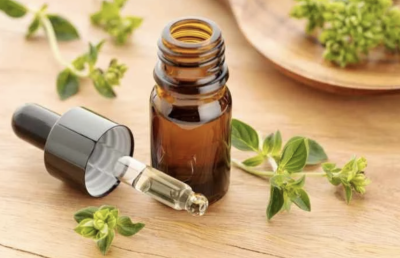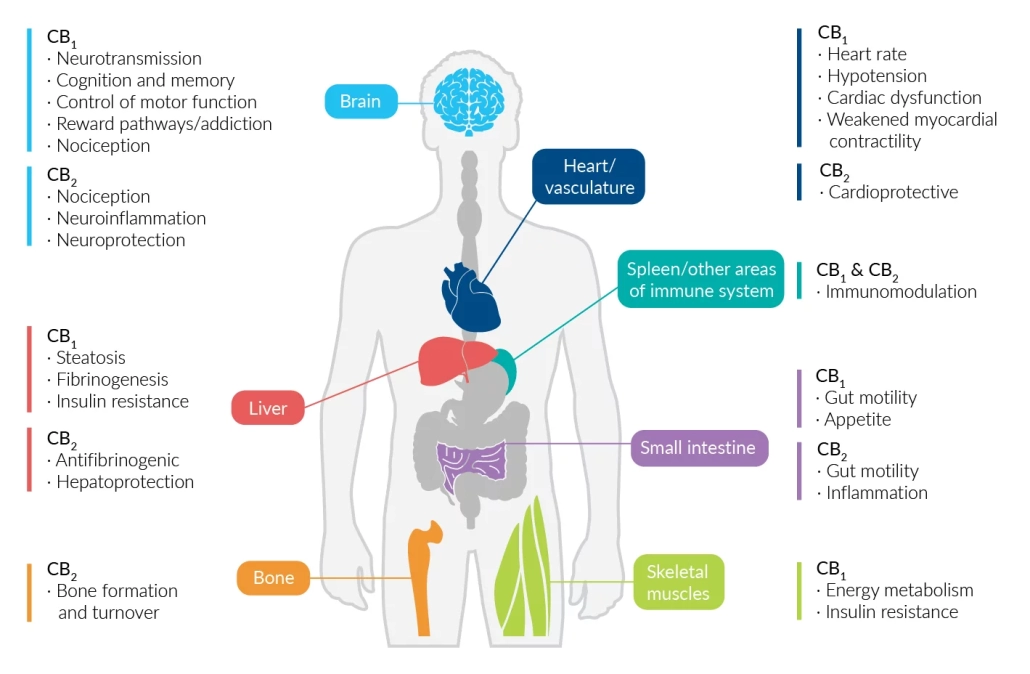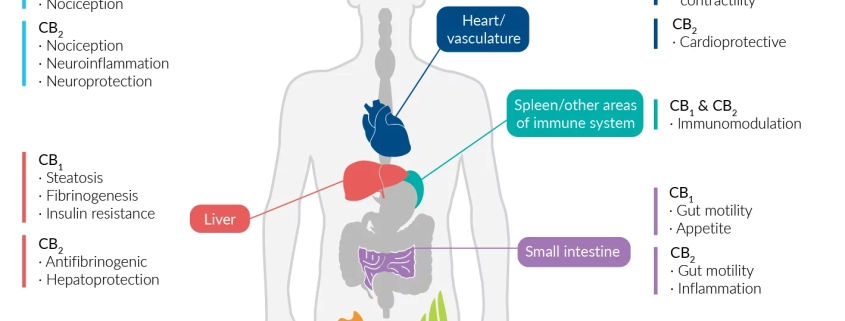What are Terpenes Effect on our Body and Health?
Exploring Terpenes Effect on our Body
Botanical terpenes, which are derived from plants, are currently highly sought-after compounds in the cannabis and CBD industry. While cannabinoids like THC and CBD have traditionally been the main drivers of market demand and research attention, terpenes are now gaining popularity as complementary therapeutic agents to cannabinoids. You may have heard of the healing effects of Essential Oils, these are made up of about 90% terpenes. So, what are terpenes effect on our body and health and what does the science say about it?
 Discover the fascinating impact of terpenes on various aspects of our lives, such as mood, sleep, pain management, stress, and numerous other biological processes. Our comprehensive guide on terpenes effect on our body delves into their pharmacological and physiological influence, the diverse effects they have, and the common methods of consumption. Whether it’s for personal health or healing from injury or disease, explore the world of terpenes to see how they may offer personalized help for your goals.
Discover the fascinating impact of terpenes on various aspects of our lives, such as mood, sleep, pain management, stress, and numerous other biological processes. Our comprehensive guide on terpenes effect on our body delves into their pharmacological and physiological influence, the diverse effects they have, and the common methods of consumption. Whether it’s for personal health or healing from injury or disease, explore the world of terpenes to see how they may offer personalized help for your goals.
Terpenes, which are organic fragrant substances known for their medicinal properties, have been utilized for centuries. Sometimes called ‘essential oils’ they are naturally found in a variety of plants, herbs, and spices, contributing to their distinct aromas. These aromatic compounds have significant applications in both the field of medicine and the fragrance industry.
Terpenes play a crucial role in the natural world, as they have the ability to discourage predators, pathogens, and competition, while also attracting pollinators. Moreover, scientific research has indicated that terpenes can contribute to the alleviation of symptoms that many people use cannabis for. Essentially, terpenes found in cannabis can enhance its therapeutic benefits while minimizing any unwanted negative effects.
Terpenes and other compounds in the cannabis plant are created in the trichomes, which are small resin glands located mainly on the cannabis buds. The concentrations of terpenes differ among different cannabis strains due to their genetics and the conditions in which they are grown. Terpenes, which are found in cannabis and other herbs, flowers and plants, are becoming more interesting to consumers due to their potential benefits and ability to work synergistically with cannabinoids like THC and CBD. However, further research is still needed to fully understand the health advantages of terpenes.
Examining the Nature of Terpenes Effects on our body: Pharmacological or Psychological?
The debate surrounding the effectiveness of terpenes in pharmaceutical drugs has long been centered on whether their various effects are caused by their pharmacological properties or by psychological factors. It is important to recognize that the terpenes effect on our body are a result of a combination of both physical and mental mechanisms.
Pharmacological
Terpenes derived from cannabis were the subject of a 2001 scientific review which explored their therapeutic benefits. The review highlighted that terpenes can affect the brain in multiple ways, such as enhancing the activity of dopamine, serotonin, norepinephrine, and GABA.
Terpenes are found in large quantities in plants, but there is a scarcity of scientific research on them, especially when it comes to human studies. The majority of studies conducted on terpenes have centered around linalool, which is commonly found in lavender, and limonene, the primary terpene found in citrus fruits.
Terpenes have been the subject of only a few studies, but the research that has been conducted highlights these potential therapeutic properties:
- Anti-inflammatory, Anti-tumor, Antibacterial, Antiviral, Anti-diabetic/hypoglycemic
- Enhances absorption via the blood-brain barrier
- Cardiovascular disease improvements
- Neuroprotective & Gastro-protective
Psychological
The way terpenes impact the body is heavily influenced by our perceptions, expectations, and aroma preferences. In a PubMed study conducted in 2003, it was discovered that there is a definite connection between changes in mood and personal odor preferences. The results revealed that pleasant odors have the ability to improve participants’ moods, decrease anxiety levels, and alleviate the discomfort caused by pain. Conversely, exposure to unpleasant odors had a negative impact on participants’ moods and intensified the unpleasantness of pain.
When it comes to cannabis, its distinct scent can potentially trigger unpleasant experiences and have a negative impact on an individual’s emotional state. Nevertheless, if someone using it recreationally encounters that same aroma, it might evoke sensations of enjoyment and enthusiasm.
In another terpene study conducted in 2004, researchers examined the impact of perception on the way odors affect individuals. During the study, participants were exposed to different odors and informed about their therapeutic properties. For instance, when a scent was labeled as soothing, the individuals involved encountered a decrease in their heart rate and skin conductivity. If the scent was perceived as invigorating, it would cause an elevation in the participant’s heart rate and skin conductance. A direct link was observed between the initial suggestion and the impact for every scent category, even in instances where no scent was introduced. It can be deduced that suggestion does play a role in the therapeutic benefits of terpene consumption. Consequently, the impact of terpenes can differ from person to person.
Understanding the Endocannabinoid System: A Comprehensive Overview
Both cannabinoids and some terpenes function by engaging with the body’s endocannabinoid system (ECS). The ECS is a network of receptors that respond to cannabinoids and certain terpenes, along with the body’s own internally-made endocannabinoids, to regulate balance within the body. It has been observed that terpenes can influence the interactions between cannabinoids and the ECS.
 Cannabinoid receptors, namely CB1 and CB2, are present throughout our bodies, in our skin and almost every cell. In addition to maintaining balance in our internal environment, the endocannabinoid system (ECS) is responsible for overseeing a wide range of biological activities, such as:
Cannabinoid receptors, namely CB1 and CB2, are present throughout our bodies, in our skin and almost every cell. In addition to maintaining balance in our internal environment, the endocannabinoid system (ECS) is responsible for overseeing a wide range of biological activities, such as:
- Sleep
- Appetite
- Mood
- Memory
- Pain Tolerance
- Metabolism
- Stress Response
- Immune Response
The ECS primarily operates within the immune and nervous systems of the body, but it also has an impact on various other bodily systems such as the circulatory, skeletal, reproductive, digestive systems, as well as the liver and connective tissues.
The Entourage Effect
The entourage effect, which was initially observed in 1998 by S. Ben Shabat and Raphael Mechoulam, refers to the scientifically proven notion that the combined consumption of multiple cannabinoid and terpene molecules is more advantageous than consuming single cannabinoids on their own. Recent research has demonstrated the multitude of benefits derived from this phenomenon.
The combination of various cannabinoids and terpenes together creates a more powerful effect, which can help minimize any negative effects of THC in cannabis. Products with a high concentration of terpenes and a full spectrum of compounds are becoming more widely favored by cannabis consumers.
Terpenes possess the capability to both enhance and suppress the effects of THC. Myrcene and linalool, which are among the most prevalent terpenes found in cannabis, are believed to amplify the sedative impact of THC. On the other hand, alpha pinene is believed to counteract drowsiness.
Certain terpenes have the ability to enhance the absorption of cannabinoids when applied topically. By interacting with the blood-brain barrier, these terpenes can effectively increase the effectiveness of cannabis-infused topical products.
Exploring the Interaction Between Terpenes and the Human Body
In the realm of plants, there is an extensive variety of over 50,000 terpenes. However, cannabis plants specifically possess a limited range of around 250 distinct terpenes. These potent terpenes have the ability to impact various aspects of our body, fostering a sense of calmness, alleviating discomfort, and enhancing the potential advantages of THC and CBD.
Below are some of the popular terpenes found in cannabis and their possible effects on the body. It’s important to note that much of the research on terpenes has been conducted using animal models, and the understanding of specifically what the terpenes effect on our body is still in its early stages.
Alpha-Pinene
Aroma: Pine
Properties:
- Anti-inflammatory
- Pain Reduction
- Anxiolytic (Anti-anxiety)
- Antibiotic
- Antioxidant
- Bronchodialator
- Enhances cognitive function, boosts focus, recall, and alertness
- Reduced THC-induced short-term memory issues
Limonene
Aroma: Lemony Citrus
Potential Benefits:
- Antibacterial
- Anti-inflammatory
- Antioxidant
- Antifungal
- Lowering the chances of developing cardiovascular conditions
- Decreases Appetite
- Alleviates Anxiety
- Enhances absorption by helping cross the blood-brain barrier
Myrcene
Aroma: Gassy Citrus, Cloves
Potential Benefits:
- Promotes Relaxation
- Alleviates Depression
- Pain Reduction
- Antispasmodic
- Anti-inflammatory
- Antioxidant
- Anti-diabetic
- Enhances absorption through skin
- Antibiotic
Humulene
Aroma: Earthy
Potential Benefits:
- Relieves pain
- Anti-inflammatory
- Reduce appetite
- Enhances absorption through skin
Beta-Caryophyllene
Aroma: Spicy, Pepper
Potential Benefits: (Interacts with ECS)
- Anti-anxiety/anti-depression
- Antibacterial
- Antiseptic
- Gastric system protection
- Antioxidant
- Promotes sleepiness
- Reduces Pain
- Anti-inflammatory
- Alleviates symptoms of inflammatory bowel disease (IBS)
- Mitigates auto-immune issues
Linalool
Aroma: Floral, Woodsy
Potential Benefits:
- Promotes Relaxation
- Reduces anxiety
- Antipsychotic
- Causes drowsiness
- Relieves depression
- Relieves pain
- Anti-epileptic
- Anti-inflammatory
- Reduces nausea
- Inhibits acne
Applications for Terpenes Effect on our body
Terpenes have been used for medicinal purposes since ancient times and continue to be popular for their therapeutic properties. Nowadays, the majority of terpenes are considered safe according to the U.S. Food and Drug Administration (FDA).
Terpenes in cannabis products can originate from either cannabis or botanical sources. Botanical terpenes are frequently utilized to produce standardized combinations in cannabis products that meet food-grade standards and are safe for consumption.
Terpenes are highly potent and volatile aromatic substances, which means that only a small quantity is required. Although terpene lab testing is still not the standard, it can provide individuals with a more comprehensive understanding of the specific compounds present in a particular strain.
Terpenes in Inhalables
In different types of cannabis, terpene levels typically fall within the range of 1% to 5%. The process of smoking cannabis heats the terpenes and aerosolizes them for inhalation. This can also cause the degradation of these terpenes, as they are sensitive to heat. To maintain the original flavor and aroma of cannabis flower buds and extracts, vaporization is considered one of the most efficient methods.
The optimal temperature range for heating terpenes is lower than that for heavier cannabinoid compounds. To maximize the enjoyment of buds and extracts, we suggest using a vaporizer with precise temperature controls and vaping terpenes at temperatures ranging from 350º to 400º F. These customized devices enable users to experience the full potential of their terpene-rich products. Terpenes in vape products, like vape cartridges, not only provide flavor but also help decrease the thickness of the extract required for heating in a vape pen.
Terpenes in Sublinguals
One of the most effective methods to enhance the absorption of cannabinoids and terpenes and bypass the initial metabolism process that takes place when consuming edibles is through sublingual administration. This technique ensures higher bioavailability of the compounds and offers a practical solution for improving their overall effectiveness. The recommended terpene concentration range for sublingual applications, as stated by the Flavor and Extract Manufacturers Association, is between 0.01% and 2%. If smaller serving sizes and less frequent usage are desired, higher terpene contents can be utilized.
Terpenes in Topicals
Terpenes, which possess aromatic qualities and offer therapeutic advantages like promoting wound healing and providing antioxidant and anti-inflammatory properties, are frequently utilized in topical products. When using cannabis topicals, terpenes can enhance the absorption of cannabinoids into the skin and amplify the entourage effect. Excessive amounts of terpenes, on the other hand, may hinder their desired therapeutic effects. In certain instances, certain terpenes can cause skin irritation when present in high concentrations. Most terpenes (essential oils) come with a warning not to use without diluting in a carrier oil first. Proper monitoring of their application in cannabis topicals is necessary to avoid severe irritation.
When it comes to topical products that stay on the skin for a long time, it is considered safe to have concentrations ranging from 0.1% to 10%. On the other hand, for products that are typically washed off, the recommended terpene concentrations can be anywhere between 10% and 24% as advised by the International Fragrance Association.
The Bottom Line
Terpenes play an important role in the aroma and flavor of a cannabis and CBD foods, lotions, and flower strains. They potentially work in synergy with cannabinoids and other cannabis plant compounds to increase or change the effects. Much of the research around terpenes is still in early stages. More high quality studies in humans are needed to fully understand the health impacts of different terpene profiles.
It’s also important to note that, in addition to cannabinoids and terpenes, your physiology, past cannabis experience, and the setting in which you use cannabis can also affect how you feel. Terpenes are just one piece of the equation, but they can be an interesting way to play around with different products and find what you like best.
More Info:
View our chart on terpenes effects on our body for some of the vape cartridge strain profiles we carry.


 leafwize
leafwize




Leave a Reply
Want to join the discussion?Feel free to contribute!